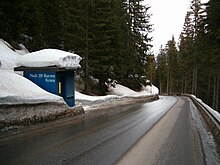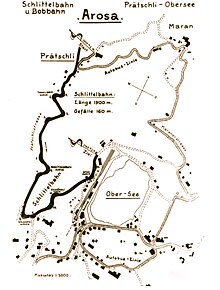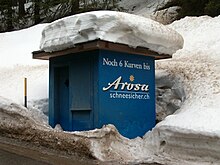Arosa bobsleigh run
The Arosa bobsleigh run in the Swiss health and sports resort of Arosa was one of the oldest bobsleigh and racing sled runs in the world. It was first put into operation in the winter of 1897/98 and existed at various locations until 1946.
The beginnings of bobsleigh and tobogganing in Arosa
With the emergence of winter tourism at the end of the 19th century , the popularity of bobsleigh and toboggan sports in Arosa increased greatly with guests and locals. So in 1896 the plan for an artificial toboggan run on the right bank of the Plessur from Mühleboden to Isel arose . In 1897 there was a first extended toboggan run from the village square down to the Grand Hotel (Savoy) (today: Robinson Club ). In that year the first "international tobogganing competition" was held, among others with well-known participants from Davos and Klosters . For this purpose, the Kurverein Arosa (today: Arosa Tourism) donated a first hiking award worth CHF 250.
On December 12, 1897, a commission consisting of three Germans, three British, two Dutch and one Swiss founded the Arosa Bobsleigh and Toboggan Club - Arosa sledging club . Its first president and probably also the initiator was the German doctor Dr. Jacobi from the Berghilf Sanatorium (today: Tschuggen Grand Hotel). When the club was founded, it already had 67 members. On January 7, 1898, the first race started on the Schanfiggerstrasse , which was opened in 1890, down to Litzirüti , the so-called Rütibahn . In the same year, another route was built with the Maranerbahn , which led from Rainweg to Seebodenplatz (Hotel Alexandra) or to the Obersee . In the following years, like the Grand Hotel-Bahn, this was partly iced up and mostly used for skeleton and toboggan rides. Use of the Eisrun Maran -Obersee was only permitted at certain hours and for a fee of CHF 2 per day or CHF 15 per season.
In the 1898/99 season, 17 competitions were held in Arosa, twelve of them on the Maranerbahn and five on the Rütibahn. On February 3, 1900, the English Tobbogan Club Arosa was finally founded by the large number of British people who were present and organized all the races together with the existing club until the outbreak of the First World War . The interest in the new sport was so great that further tracks temporarily followed: In 1911, the Plessur toboggan club, founded the year before, set up a facility from the Egga via Arosa Kulm Hotel over the Mühleboden to the Arosa Saw, and in 1914 the first track was finally built the Prätschlistrasse.
The bobsled run to Litzirüti (Rütibahn)
The most famous Arosa Railway was the one from the Usser Wald to the Plessur Bridge below Litzirüti. It was the longest and most demanding route in Switzerland. The Rütibahn was mainly available for bobsleighs and larger sledges. The first race took place on January 7, 1898.
1897 to 1914
Due to its great gradient, the route, on which horse-drawn carts and pedestrians had to move until 1914, was initially not iced over. At the four most important points, however, the curves were already protected with large walls of snow. This was necessary because in the early days the spectators liked to stay on the outside of the corners, which led to some dangerous situations.
At that time, due to the prevailing conditions, it was not possible to enter the big corners without braking. Falls were the order of the day and the audience responded with shouts of joy. The pilot required good training and an iron nerve. Every prospective helmsman had to earn a "lay in man" (passenger) job for one or two winters. Then he could switch back to the brakes. Being a breaksman wasn't a great pleasure back then; On the track with sled tracks and holes, the bobsled often jumped meters high and the goalkeeper, who could only hold on to the brakes, was never allowed to let go of them and had to stay seated in any case. That is why he usually came home in the evening completely exhausted. Military discipline also prevailed on the companions: the helmsman had to let his people lie behind him on the left and right and scratch in the snow so that the bobsled did not tip over. Under the British circulated in the light of these requirements, the saying: In St. Moritz Bobsleigh is a pleasure in Arosa a sport .
Regardless of this, the bobsleigh and toboggan sport was hugely popular even before the opening of the Arosa Railway, especially among the numerous counts, barons, lords and attachés present. There were bobsleigh races in which more than 20 four-man bobsleigh took part. After the competitions, they had to be brought back to Arosa by horse and cart from the finish area at the "Rütihof" restaurant. The racing committee always drove to the start and finish in a closed sleigh, "expressing the entire dignity of the race management to the outside world".
1914 to 1927
The opening of the Chur-Arosa railway on December 11, 1914 meant that road traffic between Arosa and Litzirüti practically came to a standstill in winter. This made it possible to close this section for a long time and to fully expand the bobsled run with its 14 curves. This was done by installing curved scaffolding and partial, artificial icing. The scaffolding was erected in November each year. The local builder Caprez and his helpers were responsible for this. Large blocks of ice and snow were removed from the Obersee and transported by rail to the large curves in Rütland. The places that could not be reached by train were served by horse-drawn sleighs. Until the general approval of automobile traffic in Graubünden in 1927, the Rütibahn was used almost exclusively for bobsleigh and tobogganing in winter. The sports equipment was now transported back to Arosa by rail, which was a great simplification.
1927 to 1935
After the approval of car traffic in Graubünden in 1927, the use of the Rütibahn became increasingly difficult as individual traffic on the road increased rapidly. This could only be temporarily blocked in the mornings and afternoons with the consent of the Canton of Graubünden. In addition, the global economic crisis forced the Kurverein Arosa to make major cost savings temporarily; In 1931 only the six main curves could be fully expanded, which led to a noticeable loss of quality. In 1933 the railroad builders only had a total budget of SFr. 2,500 available. This meant that the curves were no longer expanded at all, only the base was prepared. In 1935, the Rütibahn was finally given up as a permanent sports facility. Occasional toboggan races took place until the late 1950s, but their execution was becoming increasingly difficult due to the need to block the road.
Routing
The start was north of the Schwarzsee at around 1717 m. ü. M. at the point where the road gets its greatest gradient. The start house - originally a wooden structure - still exists today; it welcomes and says goodbye to the guests traveling by car. The run was 3,027.6 m long, the difference in altitude was 313 m with an average gradient of 10.34%. From the start to the first bend (large curve or SOS rank) 732.6 m had to be passed, to the S-curve 1,512.6 m and to the Rütihof 2,502.6 m. The track record for tobogganing was 5.24 minutes and for bobsleigh 4.49 minutes.
The curves were named according to geographical criteria.
| Kuven number | Surname | Reason for naming |
|---|---|---|
| 1. | begin | At the start house, at kilometer 27.4 of the Schanfiggerstrasse (today's measurement). |
| 2. | First forest curve | First right turn in the Usser Wald (Höhrain). |
| 3. | Big curve (SOS rank) | The first bend after the steepest section. Key point. After car traffic was permitted, an ACS emergency telephone was located here . |
| 4th | Chocolate Rank | Big left turn with a field of spectators. Warm chocolate milk was served there. |
| 5. | Rütland curve | 90-degree right-hand bend in Rütland before approaching the S-bend. |
| 6th | S curve | Right-left combination (90 degrees each) below Rütland. Key point. |
| 7th | Plant garden | Right curve before the first underpass of the Arosabahn. At the lower end of the Rütland meadow there was a plant garden. |
| 8th. | 1. Viaduct | Left-right combination after the underpass of the 1st viaduct. |
| 9. | 2. Viaduct | Two consecutive left turns after the underpass of the 2nd viaduct. |
| 10. | Rüti curve | Big right curve when leaving the forest in the Litzirüti. Key point. |
| 11. | Alpenhof curve | Long left curve at the Alpenhof restaurant (today the Valbella sports and holiday home). Fastest corner. |
| 12. | 3rd viaduct | Left curve after the underpass of the 3rd viaduct in the Rüti. |
| 13. | Bridge curves | Curves at the bridge over the Seebach. |
| 14th | End curve | Second and last turn to the right just before the goal. Key point. |
| 15th | Finish and run | The goal was just before the plessure. The target house was on the right. It no longer exists today. The exit took place via the left curve onto the Plessur bridge. |
Major events
In its almost 40-year history, the Rütibahn has hosted various top-class races in the four and two-man bobsleigh categories, as well as skeleton and racing sleds. 21 different trophies were fought for, including the International Bobsleigh Challenge (winner of the two-man bobsleigh in 1910: Joachim von Ribbentrop with his father on "Meteor"), the Philip's and the Victoria Cup. In 1920, 1922, 1926 and 1931 the Swiss championships took place on this route; The only exception were the skeleton competitions, which were held on the Maraner course. For the implementation of the bobsleigh and skeleton world championships , which had only been held since 1930, the track could no longer be considered in view of the changed circumstances since 1927.
Rütibahn connoisseurs
Due to the above-average demanding facility, the local applicants at the time of the Rütibahn were among the best in Switzerland and won various national championship titles in all important categories. In the Olympic Winter Games in Chamonix in 1924 and in St. Moritz in 1928 , the famous four-man bobsleigh team led by Charles Stoffel was each a team from Arosa.
The Prätschli-Obersee railway (Prätschlibahn)
As early as 1927, suitable alternatives for the Rütibahn were sought and the first project for a bobsled run from Prätschli to Obersee was drafted . In 1930 the feasibility of a new route to Litzirüti was examined; However, the extensive clearing in the Usserwald and the costs that would have been necessary for this stop this project. In 1935 the decision was made to expand the Prätschlistrasse into a bobsleigh and toboggan run. The route leading past the Tschuggenlift and Waldhotel National was 1,806 m long and climbed a height of 160 m with an average gradient of 8.6%. The start was above the Hotel Prätschli at 1,900 m. ü. M., the destination on Tomelistrasse behind the Arosa train station . The facility had 13 developed curves and was especially designed for two-man bobsleighs, skeletons and sledges. Major expansions were made to the facility in 1938 and 1941. The annual highlight on the Prätschlistrecke was the Arosa Grand Prix . The course record was 2.52.6 minutes. In 1942, 1944 and 1945 the Swiss Toboggan Association held the national championships for two-man bobsleighs and sledges on the Prätschlibahn. In 1946 the facility was used in particular by American army vacationers. Since the run was not suitable for four-man bobsleighs and the responsible authorities had come to the conclusion that the bobsleigh sport, which has now become quite professional, no longer met with enough interest from the guests present, the construction of the Prätschlibahn was abandoned from 1947. An ideas competition launched by the Arosa sledging club for a completely new bobsleigh run did not bear enough fruit, which marked the end of bobsleigh and luge sports in Arosa.
Bobsleigh school
Despite the difficult situation in the middle of the war, the Arosa toboggan club opened the first Swiss bobsleigh school in 1942/43. From January 22, 1943 on, bobsleigh lessons were given for one week. When the bobsleigh runs were discontinued in 1947, the bobsleigh school was also discontinued.
Todays situation
Since 1947, no more tracks have been built in Arosa for sports purposes. 1967 took place for around SFr. 100,000 .-- the construction of the Tschuggen -Tschuggen Grand Hotel toboggan run - since 2011 with a variant of the valley station of the Kulm gondola lift - and a few years ago the new construction of the illuminated Prätschli-Seewinkel toboggan run. An almost three kilometer long route also leads on the hiking trail from Untersee via the reservoir to the Litzirüti. These facilities are only used for general tourism operations and no longer allow qualified races. The old start house of the Rütibahn could be saved from being dismantled in the mid-1990s and its exterior was redesigned.
literature
- Ernst Rahm: Arosa sledge fun, 100 years of winter sports 1885 - 1985 , Arosa 1985.
- Nicole Maron: Fritz Maron - A life for Arosa , self-published by Nicole Maron, Arosa 2010, ISBN 978-3-033-02274-4 , p. 58 ff.
- Ueli Haldimann (ed.): Hermann Hesse, Thomas Mann and others in Arosa - texts and images from two centuries , AS Verlag und Buchkonzept AG, Zurich 2001, ISBN 3-905111-67-5 , p. 104.
- Hans Danuser : Arosa - as it was then (1996-2003) , Vol. 7, self-published by Danuser, Arosa 2004, pp. 11, 22.
- Hans Danuser: Arosa - as it was then (1979–1995) , vol. 6, self-published by Danuser, Arosa 2002, p. 16, 230.
- Hans Danuser: Arosa - as it was then (1962–1978) , Vol. 5, self-published by Danuser, Arosa 2001, pp. 90, 100, 123.
- Hans Danuser: Arosa - as it was then (1947–1961) , Vol. 4, self-published by Danuser, Arosa 2000, pp. 28, 89, 171, 200.
- Hans Danuser: Arosa - as it was then (1928–1946) , Vol. 3, Eigenverlag Danuser, Arosa 1999, pp. 56, 63, 99, 156, 159, 191, 204, 207, 209, 220, 224, 239 , 243, 254.
- Hans Danuser: Arosa - as it was then (1907–1928) , Vol. 2, self-published by Danuser, Arosa 1998, pp. 24 ff., 57, 126 f., 133, 175, 218.
- Hans Danuser: Arosa - as it was then (1850–1907) , vol. 1, self-published by Danuser, Arosa 1997, p. 94 ff., 163.
- Hans Danuser, Ruedi Homberger: Arosa und das Schanfigg , self-published by Danuser / Homberger, Arosa 1988, p. 110 ff.
- Kurverein Arosa (Ed.): Arosa - Climatic mountain health resort : For the anniversary 100 years Kurverein Arosa, 1884–1984, Arosa 1984, p. 7, 85–88.
- JB Casty: Arosa - From the local history of the world-famous health resort , Verlag Kur- und Verkehrsverein Arosa, Arosa 1959, p. 119.
- Fritz Maron: From mountain farming village to world health resort Arosa , Verlag F. Schuler, Chur 1934, pp. 85 ff., 167 f.
Web link
Individual evidence
- ↑ Hans Danuser: Arosa - as it was then (1907-1928) , vol. 2, self-published by Danuser, Arosa 1998, p. 25.
- ^ Hans Danuser, Ruedi Homberger: Arosa und das Schanfigg , self-published by Danuser / Homberger, Arosa 1988, p. 110 f.
- ↑ Video clip award ceremony for the Arosa bobsleigh race with Hans Roelli (rich cup) and Fritz Maron (with list of winners) (before 1930)
- ↑ Video clip of the Arosa bobsleigh run in full expansion
- ↑ Video clip of the Arosa – Litzirüti bobsleigh race
- ↑ Video clip of the Arosa bobsleigh run in a reduced version
- ↑ Video clip of the Arosa bobsleigh run with start house
- ^ Fritz Maron: Vom Bergbauerndorf zum Weltkurort Arosa , Verlag F. Schuler, Chur 1934, pp. 86, 168.
- ↑ Ernst Rahm: Arosa sledge fun, 100 years of winter sports 1885 - 1985 , Arosa 1985, p. 15.
- ↑ Hans Danuser: Arosa - as it was then (1928-1946) , vol. 3, self-published by Danuser, Arosa 1999, p. 63.
- ^ Hans Danuser: Arosa - as it was then (1907–1928) , Vol. 2, self-published by Danuser, Arosa 1998, p. 175.
- ↑ Prätschlibahn video clip
- ↑ Video clip of the Prätschlibahn race
- ↑ Video clip of the Prätschlibahn race
- ↑ Hans Danuser: Arosa - as it was then (1928-1946) , vol. 3, self-published by Danuser, Arosa 1999, p. 156.
- ↑ Video clip Swiss Championships 1942
Coordinates: 46 ° 47 '16.6 " N , 9 ° 41' 28.8" E ; CH1903: 771986 / one hundred and eighty-four thousand three hundred thirty-four











